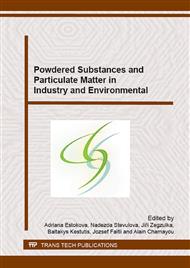[1]
H.F.W. Taylor, Cement Chemistry, 2nd ed., Thomas Telford, London, (1997).
Google Scholar
[2]
I.G. Richardson, The calcium silicate hydrates, Cem. Concr. Res. 38 (2008) 137-158.
Google Scholar
[3]
X. Zhang, W. Chang, T. Zhang, C.K. Ong, Nanostructure of calcium silicate hydrate gels in cement paste, J. Am. Ceram. Soc. 83 (2000) 2600–2604.
DOI: 10.1111/j.1151-2916.2000.tb01595.x
Google Scholar
[4]
S. Masse, H. Zanni, J. Lecourtier, J.C. Roussel, A. Rivereau, High temperature hydration of tricalciumsilicate, the major component of portland cement: a 29Si NMR Contribution, J. Chem. Phys. 92 (1995) 1861–1866.
DOI: 10.1051/jcp/1995921861
Google Scholar
[5]
S. Khurana, R. Banerjee, U. Gaitonde, Energy balance and cogeneration for a cement plant. Appl. Therm. Eng. 22 (2002) 485-494.
DOI: 10.1016/s1359-4311(01)00128-4
Google Scholar
[6]
N.A. Madlool, R. Saidur, M.S. Hossain, N.A. Rahim, A critical review on energy use and savings in the cement industries. Renew. Sust. Energ. Rev. 15 (2011) 2042-(2060).
DOI: 10.1016/j.rser.2011.01.005
Google Scholar
[7]
E. Benhelal, G. Zahedi, G. Shamsaei, A. Bahadori, Global strategies and potentials to curb CO2 emissions in ccement industry. J. Clean. Prod. 51 (2013) 142-161.
DOI: 10.1016/j.jclepro.2012.10.049
Google Scholar
[8]
P. Stemmermann, U. Schweike, K. Garbev, G. Beuchle, Celitement – a sustainable prospect for the cement industry, Cement International, 8 (2010) 52.
DOI: 10.1680/jadcr.17.00016
Google Scholar
[9]
P. Stemmermann, G. Beuchle, K. Garbev, U. Schweike, Celitement®—A new sustainable hydraulic binder based on calcium hydrosilicates, 13th International Congress on the Chemistry of Cement, Madrid, July 2011, 158.
Google Scholar
[10]
R. Siauciunas, J. Mikaliunaite, L. Urbonas, K. Baltakys, Tribochemical and thermal activation of α-C2S hydrate as precursor for cementitious binders, J. Therm. Anal. Calorim. 118 (2014) 817-823.
DOI: 10.1007/s10973-014-3921-1
Google Scholar
[11]
T. Yano, K. Urabe, H. Ikawa, T. Teraushi, N. Ishizawa, S. Udagava, Structure of α-dicalcium silicate hydrate, Acta. Cryst. 49 (1993) 1555–1559.
DOI: 10.1107/s0108270193004767
Google Scholar
[12]
H.F.W. Taylor, G. E. Bessey, Review of hydrothermal reactions in the system lime-silica-water. Mag. Concr. Res. 2 (1950) 15.
Google Scholar
[13]
H.F.W. Taylor, Calcium Silicate Hydrates, The Chemistry of Cements, London, (1964) 167.
Google Scholar
[14]
B.V. Imlach, H.F.W. Taylor, Prolonged Hydrothermal Treatment of Cement Mixes I. Curing in Water under Saturated Steam Pressure at 140-170 °C, Brit. Ceram. Trans. J., 71 (1972) 71.
Google Scholar
[15]
T. Mitsuda, S. Kobayakawa, H. Toraya, Characterization of hydrothermally formed CSH, The 8th International Congress on the Chemistry of Cement, Rio de Janeiro, 1986, 3, p.176.
Google Scholar
[16]
H. Ishida, S. Yamazaki, K. Sasaki, Y. Okada, T. Mitsuda, α-dicalcium silicate hydrate – preparation, decomposed phase, and its hydration, J. Am. Ceram. Soc. 76 (1993) 1707.
DOI: 10.1111/j.1151-2916.1993.tb06638.x
Google Scholar
[17]
K. Garbev, B. Gasharova, G. Beuchle, S. Kreisz, P. Stemmermann, First observation of α-Ca2[SiO3(OH)](OH)-Ca6[Si2O7][SiO4](OH)2 phase transformation upon thermal treatment in air, J. Am. Ceram. Soc. 91 (2008) 263.
DOI: 10.1111/j.1551-2916.2007.02115.x
Google Scholar
[18]
J.M. Butt, L.N. Raskovic, D.M. Heiker, A.A. Maier, O.I. Goratschewa, The formation of calcium hydrosilicates and its chardcterization, Silikattechn, 12 (1961) 281.
Google Scholar
[19]
K. Baltakys, T. Dambrauskas, R. Siauciunas, A. Eisinas, Formation of α-C2S hydrate in the mixtures with CaO/SiO2 = 1. 75 by hydrothermal treatment at 200 °C, Rom. J. Mater. 44 (2014) 109-115.
Google Scholar
[20]
K. Baltakys, R. Siauciunas, Formation of gyrolite in the CaO-quartz-Na2O-H2O system, Mater. Sci-Poland, 25 (2007) 1089-1100.
Google Scholar
[21]
K. Baltakys, R. Siauciunas, Influence of gypsum additive on the gyrolite formation process. Cem. Concr. Res. 40 (2010) 376-383.
DOI: 10.1016/j.cemconres.2009.11.004
Google Scholar
[21]
K. Baltakys, R. Siauciunas, The influence of γ-Al2O3 and Na2O on the formation of calcium silicate hydrates in the CaO-quartz-H2O system, Mater. Sci-Poland,. 25 (2007) 185-198.
Google Scholar
[22]
N. Meller, K. Kyritsis, C. Hall, The mineralogy of the CaO–Al2O3–SiO2–H2O (CASH) hydroceramic system from 200 to 350 °C, Cem. Concr. Res. 39 (2009) 45-53.
DOI: 10.1016/j.cemconres.2008.10.002
Google Scholar
[23]
K. Baltakys, A. Eisinas, T. Dambrauskas, The influence of aluminum additive on the α-C2S hydrate formation process, J. Therm. Anal. Calorim. 2015. DOI: 10. 1007/s10973-015-4591-3.
DOI: 10.1007/s10973-015-4591-3
Google Scholar


